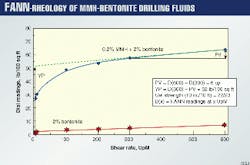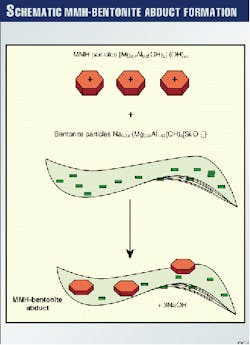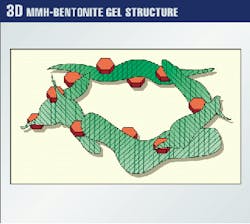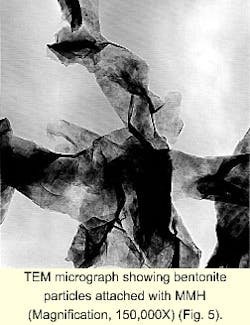MMH-bentonite fluids provide outstanding performance in oil field drilling
Mixed metal hydroxides (MMH) with suspended bentonite particles give industry a cost-effective fluid system with excellent shear-thinning rheological properties.
This happens through a cross linking of bentonite particles with bridging MMH particles.
The oppositely charged bentonite and MMH particles create a viscous fluid through attraction within a three dimensional (3D) network. The attachment of MMH particles on bentonite platelets, and also their common network, can be observed with a transmission electron microscopy (TEM).
As the MMH-bentonite interaction is weak, viscosity breaks down readily with application of small shear forces. Field results of oil field and construction drilling applications demonstrate the effectiveness and the economic benefit of MMH-bentonite fluids compared to biopolymer solutions.
Shear-thinning drilling fluids
The drilling fluid is important for successful drilling in oil and gas exploration or tunnelling beneath streets and rivers. Besides functions like cooling and lubricating the drill bit and stabilization of the bore hole, the drilling fluid serves to provide hole cleaning properties through cuttings transport.
Therefore, it is important to design a suitable fluid rheology. Fluids with good pumpability and low viscosity at a high shear rate that create a higher viscosity at a low shear rate are advantageous for this application. These are known as "shear-thinning" fluids.
Fluids of this kind, whose viscosity is decreasing with growing shear stress, are characterized by a low plastic viscosity (PV) and a high yield point (YP). According to the current state of the art, special biopolymers like Xanthan gum are well-suited for such shear-thinning fluid properties.
One disadvantage of biopolymers, however, is their high cost. Because of this, MMH was introduced into the market a few years ago as a cost-effective alternative.1 2
This article describes and summarizes research on the interaction between MMH and bentonite by means of transmission electron microscopy (TEM). Based on these results, a model is suggested for the explanation of shear-thinning properties of MMH-bentonite fluids.
MMH: Production and chemical structure
MMH or layered double hydroxides (LDH) are a class of clay-like minerals with a characteristic layer structure. The type of MMH which is well proven in the drilling industry is synthesized by a complex and demanding production process. The raw material consists of a synthetic hydrotalcite (HTC), which is a Mg-Al-carbonate MMH.
HTC is activated through a precisely defined thermal reaction at about 500° C. According to Equation 1 (Equation box), white Poly (magnesium-aluminum-oxide-hydroxide) crystals are formed with a well-defined surface. This commercially available material is called "MMH."
If this MMH is added to water, the layered structure of hydrotalcite is recreated; however, OH- anions are formed instead of carbonates between the layers (Equation 2). This hydrated MMH forms the true viscosifying compound.
Fig. 1 shows the characteristic layer structure of MMH in water. One layer consists of two stacked hydroxide ion layers, which form octahedral spaces. Each of these octahedral spaces is filled with a metal cation.
Deviating from the known Mg(OH)2-Brucite structure, with MMH, a fraction of these magnesium cations is exchanged by trivalent aluminum. The higher positive charge of Al3+ compared to Mg2+ results in an excessive positive charge within a layer. Whereas the neutral layers of the Brucite structure are connected through hydrogen bonds, the hydrated MMH shows separated cationic layers.
The excessive positive charge is compensated through exchangeable anions (OH-) between the layers and on the crystal surfaces. This leads to the shown sandwich structure.3 4
MMH: The viscosifying effect
If MMH particles are dispersed in bentonite suspensions, they develop their unique thickening effect. Fig. 2 shows very clearly that the addition of only 0.2% of MMH to a 2% bentonite suspension increases the viscosity of this suspension dramatically.
While the plastic viscosity stays very low (6 cp), the yield point is increased from 3 to 52 lb/100 sq ft. The addition of MMH, therefore, leads to a fluid with an extremely shear-thinning rheology.
MMH-bentonite fluids are characterized through instantaneous gelation, when the fluid is at rest. In contrast to biopolymer solutions of a comparable rheology, this highly viscous MMH gel is able to carry cuttings of several kilograms.
If mechanical energy is applied to the fluid, for example in form of a pumping process, this gel is converted to a shear-thinning fluid. High shear stresses, e.g., in pumps, result in a locally low-viscous fluid. If the shear stress is removed, the gel structure recovers instantaneously and completely.
The gel strength of MMH-bentonite fluids is nonprogressive, which allows the fluid to be easily pumped after longer times at rest.
This unique viscosifying effect of MMH in clay and water-based drilling fluids raises the question after the mode of action on which the effect is based. The following discussion presents a model for interpretation of the rheology phenomenon which is based on TEM-micrographs.
MMH: Model for the mode of action
According to the layer structure mentioned above, MMH crystals exhibit positively charged surfaces. The charge distribution of MMH in water is the reverse of bentonite, which shows negatively charged basal planes with cations between the layers.5 6 Therefore, it can be expected that MMH particles (diameter approximately equal to 0.1m will attach immediately to the oppositely charged surfaces of the bigger bentonite particles (diameter approximately equal to 0.1m. An adduct of bentonite and MMH is formed through electrostatic interaction between oppositely charged basal areas.To compensate for the excessive charges, small amounts of mobile interlayer ions, Na+ from the bentonite and OH- from hydrated MMH are liberated as NaOH. Fig. 3 shows a schematic drawing of MMH-bentonite adduct formation.
How can the rheological properties of MMH-bentonite fluids be explained?
Because the neutralization of excessive charges should be as complete as possible, it can be expected that at least part of the hydrated MMH particles are attached to clay particles at its upper and lower side.
This would enable the formation of a 3D MMH-bentonite network (Fig. 4). It is clear that such a network would lead to unusually high viscosities.
Experimental
For the TEM micrographs, a usual MMH lab fluid was prepared: A suspension containing 2% of Wyoming bentonite in fresh water was stirred on a Hamilton Beach mixer at low speed. Then, 0.2% of MMH was added to the fluid and the pH raised to 10.5-11 with a NaOH solution.
After stirring for 45 min, a small droplet of this fluid is fixed in liquid propane by using a Reichert-Jung KF80 freezing apparatus. A Philips Type CM12 with EDX-detector was used for the electron microscopic photographs.
TEM micrographs
TEM micrographs of bentonite fluids and MMH-bentonite fluids were prepared and compared to verify the model of the MMH-bentonite interaction. According to this model, in the presence of MMH, small attachments can be seen on the basal planes of Wyoming bentonite. In some cases, even the ideal hexagonal crystal shape of the hydrated MMH particles is visible (Fig. 5). According to EDX-analysis, the particles on the bentonite platelets exhibit a Mg-Al ratio of about 2.5, and therefore can be identified as MMH.
Fig. 6 shows a TEM micrograph visualizing very clearly the 3D network of a MMH-bentonite fluid. In contrast to pure bentonite suspensions, where edge-to-face attachment of bentonite particles is described in the literature,5 6 here face to face attachments are dominating. The bentonite particles attached with MMH are deformed, folded, and twisted, which results in a 3D network structure.
Explanation of shear-thinning viscosity
The special way of cross linking between bentonite particles and MMH is considered to be the reason for their shear-thinning properties. The relatively weak electrostatic interaction between hydrated MMH particles and bentonite can be broken easily by shear stress.
As a consequence, the network is destroyed and the viscosity is reduced drastically to a level comparable to a pure bentonite suspension. After removal of the shear stress, the 3D MMH-bentonite network and the viscosity are recreated instantaneously.
Oil field applications
The unique rheological properties of MMH-bentonite fluids are extremely advantageous for drilling fluids, both in oil field and in trenchless drilling for subterranean tubes and cables. For oil wells, the system is proved to be the fluid of choice for top hole drilling, milling, and horizontal drilling.7-11
The high carrying capacity of MMH-bentonite fluids and the gelation at rest have reduced different adverse effects dramatically. In oil and gas exploration, horizontal drilling is a frequently applied technique to increase the production rate of the oil-bearing formation. In this field a major concern is the settling of drill cuttings when the drilling process and fluids circulation are interrupted. This may lead to serious stuck-pipe problems. Field results confirm that MMH-bentonite fluids suspend most drill cuttings perfectly and provide effective cuttings transport when the fluid is in circulation.
A successful application of the MMH-bentonite system is reported from a horizontal well offshore Louisiana in a high-permeability unconsolidated sand. The drilling fluid was based on freshwater and seawater, 10 lb/bbl bentonite, 1 lb/bbl MMH, and adjusted to a pH of 10.5-11 with caustic soda.
The rheology of the fluid was as follows: PV 5, YP 53, Gels (10 in./10 ft) 25/26. The fluid was weighted up to a specific gravity of 10.5 with ground marble, which also provided fluid loss control for the permeable sand. The annular fluid velocity was about 65 fpm, and the horizontal section of 950 ft was drilled at an average rate of penetration of 165 fph.
The hole was always clean, open, and in gauge. Due to the minimal impact of the ground marble treated MMH drilling fluid on the formation, the operator reported high well productivity without the need for stimulation treatments.
Another important application of MMH-bentonite fluids is milling of damaged casing sections. With these operations, large amounts of metal scrap, resembling bird nests and crumbs of hardened cement, have to be suspended and carried to the surface. This has caused frequent and severe problems in the past. A field report from Norway proves that based on their unique rheology, MMH-bentonite fluids are well-suited for these milling operations.
The applied fluid was prepared in freshwater as a concentrate first (16 lb/bbl bentonite, 1.6 lb/bbl MMH, pH 10.5-11 with NaOH) loaded with barite, and finally adjusted to the necessary rheology by cutting back with seawater (YP = 78 lb/100 sq ft, PV = 10 cp, density = 11.5 ppg). The 133/8-in. casing was removed over a distance of 1,297 ft without problems and with a milling rate of 14 fph. On average, a maximum milling speed of 25 fph was achieved. Based on these results the operator characterised the MMH-bentonite fluid as efficient and economical compared to previously used biopolymer-based solutions.
Construction-drilling application
The MMH-bentonite fluid system has proven to be the fluid of choice especially for drilling of gravel formations. A field application from Magdeburg, Germany, demonstrates the successful application under these conditions.
For the purpose of pipeline laying, a 710-ft tunnel, 3-ft wide, was drilled below a river through a gravel formation. The applied freshwater fluid, containing 3.5% bentonite, 0.35% MMH, and 0.3% soda ash, resulted in an optimum carrying capacity at a pump rate of 35 sq ft/min. The project was complete within 2 days without bore hole collapse.
Outlook
MMH provides the drilling industry a very cost-effective fluid system with excellent shear-thinning rheological properties. Recently, it was possible by application of a new MMH technology to improve the temperature stability of the MMH system to over 400° F. (200° C.).
According to industry knowledge, this MMH-clay system is the only shear-thinning fluid that works in this temperature range and in the presence of electrolytes.
References
- SKW product literature, POLYVIS II-MMH viscosifier for water-based drilling fluids.
- Felixberger, J., "Mixed Metal Hydroxides-A New and Unique Inorganic Viscosifier for Water-Based Drilling Fluids," Erdöl Erdgas Kohle, 1997, p. 12.
- Serna, C., White, J., and Hem, S., "Structural Survey of Carbonate-Containing Atacides," Journal of Pharm. Sciences 67, 1978, p. 324.
- Reichle, W.T., "Anionic clay minerals," Chemtech, 1986, p. 58.
- Grim, R.E., Clay Mineralogy, McGraw-Hill, new York, 1969.
- Darley, H.C.H., and Gray, G.R., Composition and Properties of Drilling and Completion Fluids, Gulf Publishing Co., Houston, 1991.
- Sparling, D.P., Mixed metal hydroxide mud improves drilling in unstable shales, OGJ, June 10, 1991, p. 29.
- Lavoix, F,. and Lewis, M., "Mixed metal hydroxide drilling fluid minimizes well bore washouts," OGJ, Sept. 28, 1992, p. 87.
- Polnaszek, S.C., and Fraser, L.J., "Drilling Fluid Formulation for Shallow Offshore Horizontal Well Applications, SPE paper 22577, 1991.
- Fraser, L., "Unique Character of Mixed Metal Hydroxide Fluids Provide Gauge Hole in Diverse Types of Formation, SPE paper 22379, 1992.
- Oyeneyin, M.B., et al., "The Formulation of Milling Fluids for Efficient Hole Cleaning," SPE paper 28819, 1994.
The Authors
Johann P. Plank is vice-president, oil field polymers group, for SKW Trostberg AG in Trostberg, Germany. Since joining SKW in 1980, he has worked in several research and marketing positions.
Plank holds a PhD in chemistry from the University of Regensburg, Germany. He is a member of SPE and the API committee on standardization of drilling fluid materials.
Gregor Keilhofer is head of application science and quality control in SKW's oil field polymers group, Trostberg, Germany. He holds a PhD in polymer chemistry from the University of Freiburg, Germany. He specializes in water-soluble polymers.
Since joining SKW in 1994, Keilhofer has participated in several research and development projects involving drilling fluids and oil well cementing. He is an associate member of SPE.
Peter Lange is a chemist with SKW's oil field polymers group. He holds a PhD in inorganic chemistry from the Technical University of Munich. Since joining the company in 1998, Lange has worked on mixed metal hydroxide technology.








